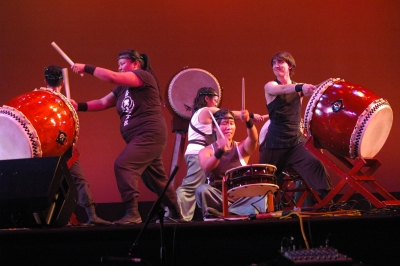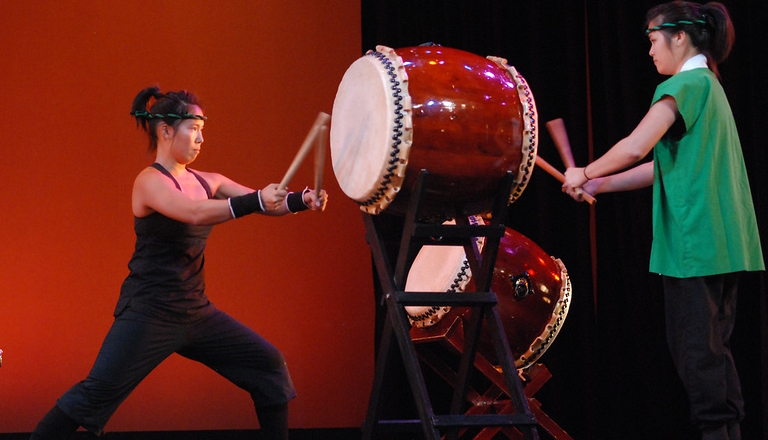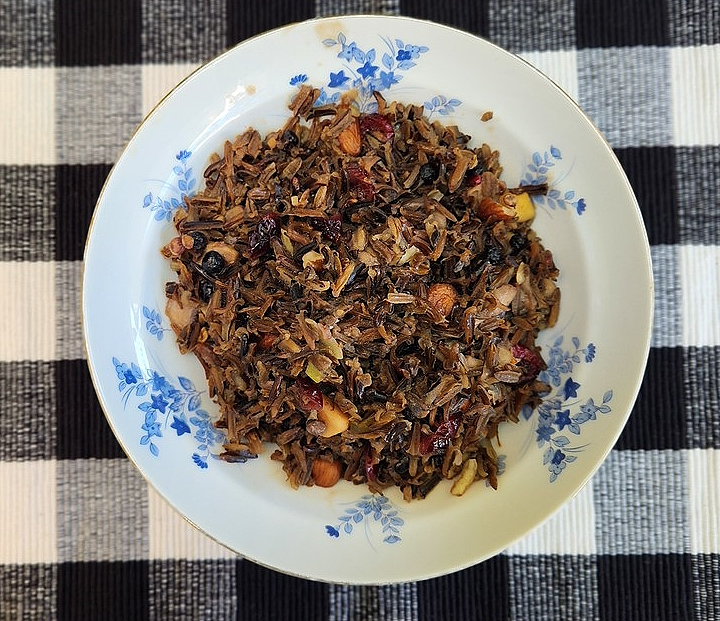|
Internationally popular, Taiko drumming is a relatively new performance tradition that employs traditional Japanese instruments in new and dramatic ways. Jazz drummer Daihachi Oguchi is credited with creating Kumi-daiko style of Taiko in 1951. The sound is exuberantly loud with complex rhythms and dramatic choreographed moves by performers which meld music with angular and precision movement (amplified in effect by black headbands), evoking a martial arts esthetic. |
Taiko: an Emerging Tradition
Taiko is used to describe the music made with Japanese drums known as Taiko. In Japanese, the word Taiko is used to describe any sort of percussion instrument that is most precisely "wide", because Taiko literally translates into "wide or fat drum". What most people in America refer to as Taiko is actually a relatively new art form known as Kumi-daiko, which is a performance consisting of multiple Taiko drums.
The use of Taiko drums in Japan dates back further than 1,400 years and its origins are most likely rooted in Chinese and Korean traditions. The exact history of Taiko drumming in Japan is unknown, but the oldest evidence of Taiko in Japan is a clay figure, dating back to the 6th or 7th century, that is shown beating a Taiko drum.
Taiko was originally used for various reasons. From the Heian era until the 14th century, Taiko was used on battlefields to intimidate enemies, as well as to give commands, motivate, and coordinate soldiers by setting a marching pace. It was also used off the battlefield; in the Edo period, Taiko drums were used for signals such as hunters beginning their hunt, fire alarms, sumo announcements, and storm warnings. Japanese people also felt that the drum had spiritual powers, calling the Taiko sound the voice of Buddha and using the drums to call to the gods during harvest time.
As Buddhism and Shinto beliefs became more prevalent, only holy men were allowed to play the Taiko drums for ceremonious reasons and occasions, and practices like these still continue today. In Japanese history, Taiko drums were played singularly and only with permission of priests. Indeed even in artistic uses of the Taiko, as in accompanying Japanese theater arts like Noh or Kabuki, the Taiko drum was played singularly. The modern group Taiko ensembles, which many people associate Taiko with today, is known as Kumi-daiko and came later in history.
Daihachi Oguchi is credited with creating the Kumi-daiko style of Taiko in 1951 post-WWII Japan. Having a background in Jazz music, Oguchi found a traditional Taiko composition and decided to rearrange it, breaking away from many Taiko traditions by using multiple Taiko drums that had different sounds and multiple, simple rhythms, and were played by non-professional musicians. The new composition was played for the Osuwa Shrine, and Oguchi's style of Taiko quickly became popular in Japan and then around the world. This style of Taiko is still very popular today and Westerners typically associate it with the sounds and performances of Taiko drumming.
Taiko Instruments

Taiko are considered sacred instruments that are created from the earth. Daiko is the word for taiko drums when used in a compound word. There are two types of taiko drums that have many varieties: byou-daiko (drums are carved from a single log, with heads stretched and tacked to the body, and thus cannot be tuned) and shime-daiko (drums with two heads that are sewn over steel rings and laced to the body with a rope or cord. A second rope is wound around the laces of the head ropes, and the drum can be tuned by adjusting the second rope.) In taiko groups, the shime is often used to keep the basic rhythm and establish time, but it can be a solo instrument as well.
Bachi - As a general rule, taiko drums are struck with sticks called bachi. Bachi come in many shapes and sizes and are made from many different types of material.
Types of Byou-daiko:
Nagado-daiko - This is the most common taiko drum used in Kumi-daiko. They are often called Miya-daiko. They have a characteristically deep and reverberating sound. These drums come in different sizes: ko-daiko (roughly 1 to 1.5 feet in diameter), chu-daiko (roughly 1.6 to 2.8 feet in diameter), and odaiko (from 2.9 to 6 feet or more in diameter).
Odaiko - The biggest of the Nagado-daiko, these drums are played horizontally on stands, often by two people at once. Odaiko can sometimes reach huge proportions and weigh over 3 tons, although these drums are used more for temples than for Kumi-daiko.
Hira-daiko - It tends to be a small drum but can reach odaiko proportions. It is popular for taiko groups to buy a very large sized hira-daiko for less than a nagado-daiko drum of the same size. They have a deep sound much like the nagado-daiko, but because of the slimmer body, the sound diminishes much faster.
Types of Shime-daiko:
Wadaiko - These drums are used for classical Japanese music. They have relatively lightweight bodies and thin heads, often with thin patches of deer skin in the middle of the heads.
Tsukeshime-daiko - These drums are used for folk music and Kumi-daiko. They are much heavier and thicker type of wadaiko, and can be tuned to a very high pitch.
Oke-daiko - They are carved from multiple pieces that are fit together. Also, they are larger than nagado-daiko - often 6 feet long with a 3 foot diameter. Like odaiko, oke-daiko are played horizontally on a stand. Short-bodied styles of oke-daiko are becoming popular. They are usually played using slat-like bamboo bachi causing the drum to produce a loud, flat sound.
By Ian Williams
Photos by Berwyn Husmann
Group Pictured: Naruwan Taiko










